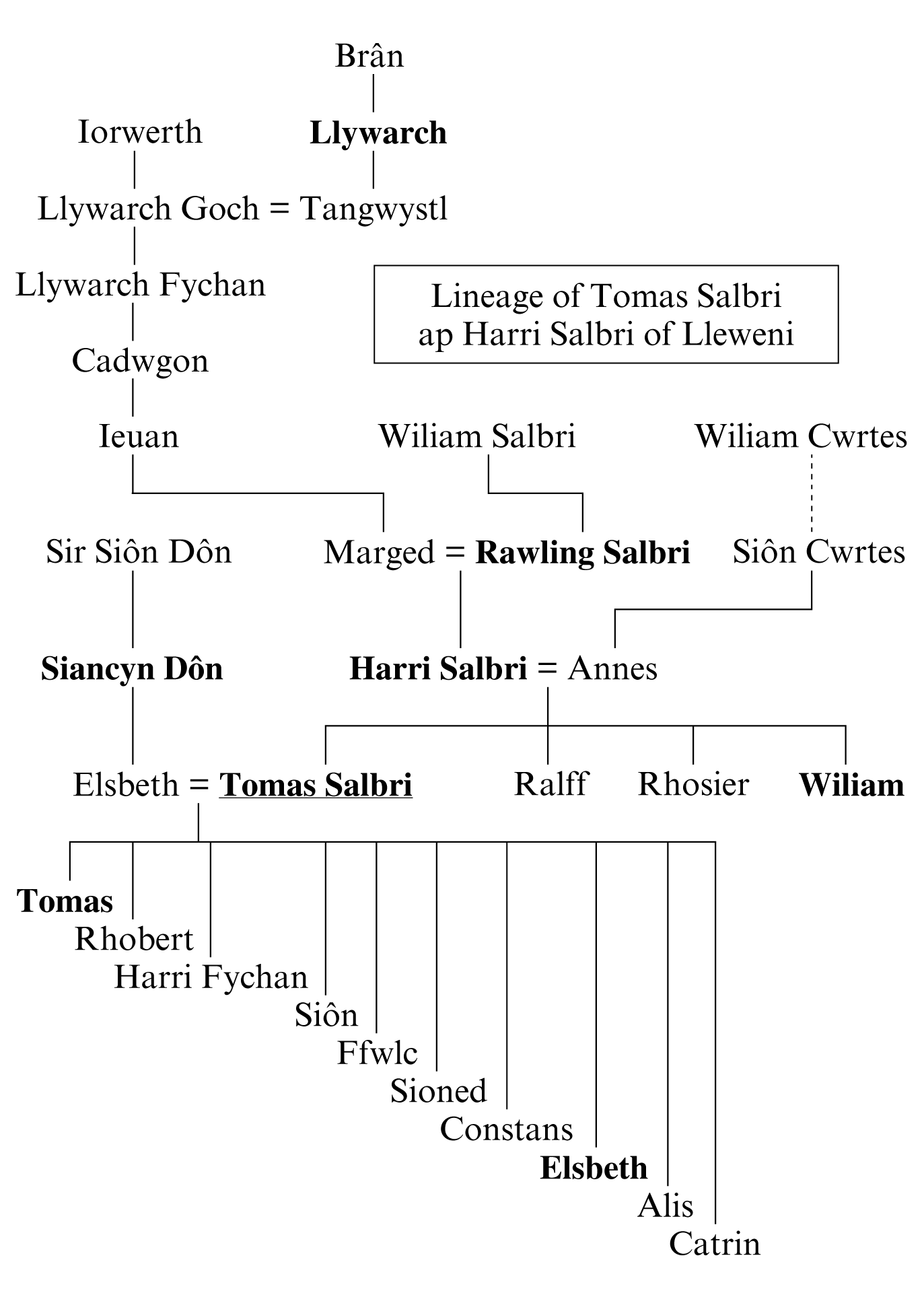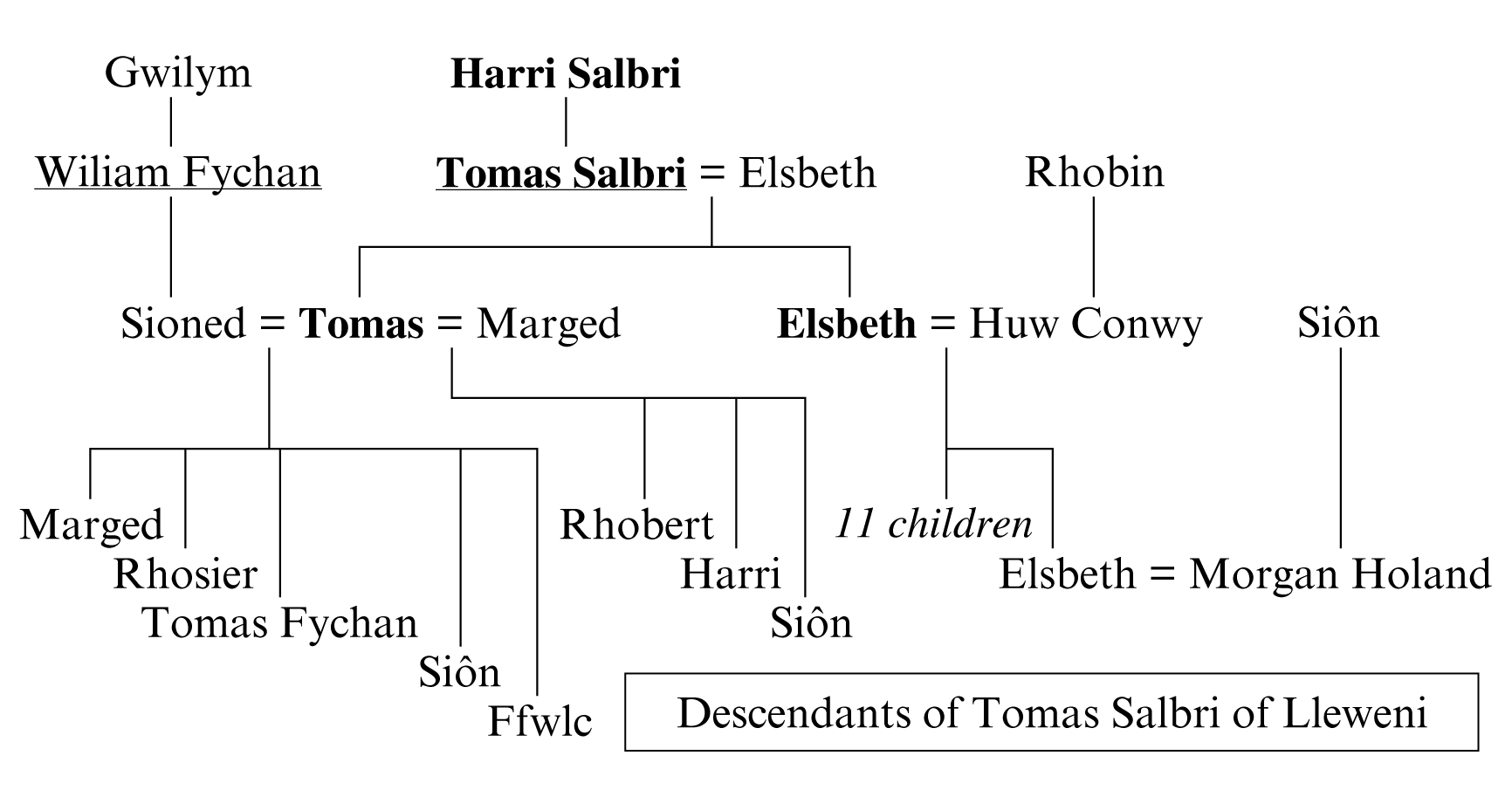Only one poem by Guto for Tomas Salbri (or Thomas Salusbury) has survived, a poem of praise (poem 71). Three elegies for him are found in the manuscripts:
- by Tudur Aled, TA poem LXXVIII (see also the note on page 668);
- by Lewys Môn, GLM poem LIV;
- by Gutun Owain, GO poem LVII.
Dafydd ab Edmwnd composed a poem which opens with praise to Tomas, yet it seems that the poem’s main patrons were Tomas’s children and that Tomas may even have not been alive when it was composed (DE poem XLIV and the note on page 156).
The earliest surviving poem for one of the Salbris of Lleweni was composed by Sypyn Cyfeiliog (Dafydd Bach ap Madog Wladaidd) for Tomas’s father, Harri ap Rawling Salbri (GSCyf poem 2, 46–52). Many poems survive for Tomas’s son, another Tomas Salbri:
- two poems of praise and an elegy by Tudur Aled, TA poems X, XXIV and XXV;
- three poems of praise and one elegy by Lewys Môn, GLM poems LV, LVI, LVII and LIX;
- a poem of praise by Gutun Owain, GO poem LVIII.
Another poem of praise, attributed to both Tudur Aled and Lewys Môn, has been edited as the work of both poets respectively (TA poem XXVI; GLM poem LVIII).
Elsbeth daughter of Tomas Salbri married Huw Conwy from Bryneuryn in Llandrillo yn Rhos. A number of poems were addressed to both Huw and Elsbeth:
- a poem praising Huw and Elsbeth by Lewys Glyn Cothi, GLGC poem 222;
- a poem of praise for the couple by Gutun Owain, GO poem XLVII;
- a poem for Huw’s home in Bryneuryn by Tudur Penllyn, GTP poem XV.
Ieuan Llwyd Brydydd also composed a poem of praise for Elsbeth’s daughter, another Elsbeth who married Morgan Holand ap Siôn (GILlF 10.51).
Lineage
The genealogical tables below are based on WG1 ‘Llywarch ap Brân’ 1, ‘Llywarch Howlbwrch’ 1, 2, ‘Marchudd’ 22; WG2 ‘Holland’ 2, ‘Marchudd’ 6 B1, 22 B1, ‘Salesbury’ 1, 2; GSCyf 46–52; GLM 461. Those named in Guto’s poem for Tomas are shown in bold print, and the names of Guto’s patrons are underlined.

Lineage of Tomas Salbri ap Harri Salbri of Lleweni
Because Guto makes much of the prestige of two of Tomas’s children, Tomas and Elsbeth, their families are also shown in the genalogical table below.

Descendants of Tomas Salbri of Lleweni
Sioned, Tomas Salbri ap Tomas Salbri’s first wife, was the daughter of one of Guto’s patrons, Wiliam Fychan ap Gwilym of Penrhyn. Also, Marged, Tomas’s daughter, married the grandson of another of Guto’s patrons, Edward ap Wiliam ap Siôn Hanmer. Tomas Salbri ap Tomas Salbri’s second wife (if she was, indeed, his wife) was Marged daughter of Siencyn.
Tomas Salbri’s career
In HPF iv: 330 it is noted that Tomas Salbri died in the battle of Barnet in 1471, yet Roberts (DE 156–7) is undoubtedly correct in dismissing this information in light of Gutun Owain’s elegy for Tomas (GO LVII.13–16; both GDT 6.37–8n and TA 668 should, therefore, be ignored):
Mil pedwar cant, – ail Antwn, –
Oedd oed Tuw pan gladdwyd hwn,
A’r ail rrif ar ôl y rrain,
Ydoedd ddec a dav ddevgain.
‘One thousand four hundred – a second St Anthony –
was God’s age when this man was buried,
and the second number after these
was ten and two forties.’
Tomas died in 1490. DNB Online s.n. Salusbury family states that Tomas was constable of Denbigh in 1454, and it seems that he is named in Owen (1978: 255) as a steward in the court of Ruthin in December 1447. Since Tomas’s father, Harri Salbri, was alive during the second half of the fourteenth century, it is likely that Tomas was very old when he died in 1480, although it is conceivable that there may be gaps in the genealogies (GSCyf 46–52; Owen 1978: 178; the identity of one Henry de Salusbury who was a burgess of Denbigh in 1418 is unclear, ibid. 183). According to GLM 463, Tomas was buried in the Carmelite friary in Denbigh.
Evans (1955: 14) states that ‘there are vague references in some Welsh poems of the period to the prowess of Thomas Salusbury (known as Hen Domas) of Llewenni [sic] in the battle of Bloreheath in 1459 – on the Shropshire, Staffordshire border, and one of the first battles of the Wars of the Roses … This Thomas was killed at the Battle of Barnet in 1471’. Evans does not state his sources and no ‘vague references’ have been found in the poetry. It seems that some other Tomas Salbri or Tomas ap Harri died in 1471.
Tomas Salbri ap Tomas Salbri, fl. c.1466–d. 1505
Tomas Salbri’s heir died fifteen years after his father, in January 1505, and he and his wife, Sioned (who died in 1515), were the last of the Salbris to be buried in the Carmelite friary in Denbigh (DNB Online s.n. Salusbury family; DE 157; Evans 1955: 14–15; GLM 463). In 1497 Tomas fought in the army of Henry VII at the battle of Blackheath (or Deptford Bridge), in south-east London today, against men from Cornwall who opposed the heavy taxes levied on them by the king in order to finance his Scottish campaigns. Following the victory, he was made a knight on 17 June (DNB Online s.n. Salusbury family; DE 157, where the date is 22 June).
Tomas was appointed constable of Denbigh on 23 January 1466 and again in the first year of the reign of Richard III, namely sometime between 26 June 1483 and 25 June 1485 (Evans 1955: 14; GGl 359; DE 157; Owen 1978: 178). It is likely that it is he who is named in Owen (ibid.) as a burgess of Denbigh in 1476. According to GLM 463 he was commissioned to gather both men and money for a campaign in France in 1491, he was both forester and regent in the lordship of Denbigh in 1501 and received another commission to survey the lordship in 1503. In GGl 359 it is noted that he held the leasehold of Flint’s mills in 1482 and was steward of Flint between 1482 and 1485 (1489 according to DN xxxiii) and again from 1495 to 1499. He was appointed deputy sheriff of the town in 1470 and 1472 and was sheriff from 1495 until his death (ibid.; DE 157).
Bibliography
Evans, W.A. (1955), ‘The Salusburys of Llewenni [sic] and the Carmelite Friary in Denbigh’, CHSDd 4: 13–25
Owen, D.H. (1978), ‘Denbigh’, R.A. Griffiths (ed.), Boroughs of Medieval Wales (Cardiff), 164–87





